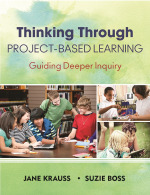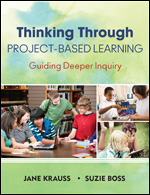Thinking Through Project-Based Learning
Guiding Deeper Inquiry
- Jane Krauss - University of Oregon, USA
- Suzie Boss
Everything you need to know to lead effective and engaging project-based learning!
Are you eager to try out project-based learning, but don't know where to start? How do you ensure that classroom projects help students develop critical thinking skills and meet rigorous standards? Find the answers in this step-by-step guide, written by authors who are both experienced teachers and project-based learning experts.
Thinking Through Projects shows you how to create a more interactive classroom environment where students engage, learn, and achieve. Teachers will find
- A reader-friendly overview of project-based learning that includes current findings on brain development and connections with Common Core standards
- Numerous how-to's and sample projects for every K-12 grade level
- Strategies for integrating project learning into all main subject areas, across disciplines, and with current technology and social media
- Ways to involve the community through student field research, special guests, and ideas for showcasing student work
Whether you are new to project-based learning or ready to strengthen your existing classroom projects, you'll find a full suite of strategies and tools in this essential book.
"Ensuring that students take the lead in critical thinking and problem solving is the key to success. This book provides educators with the tools to get students ready for real-world learning and collaboration."
—Tania E. Dymkowski, Instructional Support K-8
Hays CISD, Kyle, TX
"A well-written, engaging book that makes even a master PBL teacher rethink her ideas. A must for all!"
—Lisa Parisi, Teacher
Denton Avenue Elementary School, New Hyde Park, NY
Free resources
Project-Based Lesson Library
Excerpted from Thinking Through Project-Based Learning, this list of over 75 project ideas—complete with guiding questions and grade ranges—is a great resource for getting started. (K-12)

Project-Based Learning Lesson Library
Excerpted from Thinking Through Project-Based Learning, this list of over 75 project ideas—complete with guiding questions and grade ranges—is a great resource for getting started. (K-12)
"The book is filled with examples of how to teach and create critical thinking experiences in project-based learning. It fulfills it purpose of helping teachers have better projects that incorporate a high level of critical thinking and authentic learning. The project-based learning spiral provides teachers with the practical guidance they need in creating critical thinking and authentic learning experiences in project-based learning."
"This book pulls together related research and current theories of PBL, brain based learning, and inquiry. Any teacher or administrator interested in or doing Project Based Learning will find this book very useful."
"The book has several purposes (doing PBL rather than just preparing, supporting educators, presenting ways to develop 21st Century skills, and developing inquiry skills) which are clearly defined in the beginning and flows into each chapter. I believe the book makes a distinct contribution because it provides for practical applications in the classroom and for lively discussion in Professional Learning communities."
"Ensuring that students take the lead is critical thinking and problem solving is the key to success. This book will provide educators with the tools to get students ready for real world learning and collaboration."
"The Ultimate Guide to PBL. A well-written, engaging book that makes even a master PBL teacher rethink her ideas. A must for all!"
"I was inspired by the projects and the positive reinforcement the students received."
Found a book that aligned better to the goals and objectives of the course. The Problem-Based Instruction course is for pre-service science teachers. We adopted Teaching Science in Elementary and Middle School by Krajcik and Czerniak (2014).
I would, however, recommend the Kruas book for general methods.
